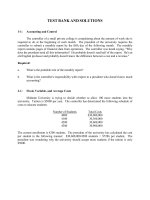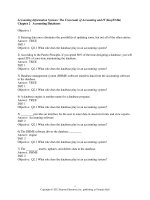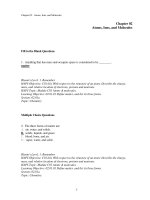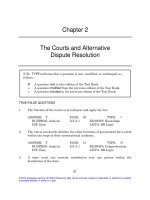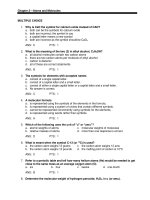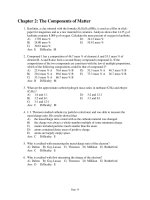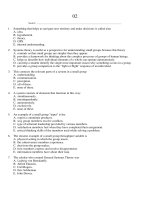Seeleys essentials of anatomy and physiology 8th edition vanputte test bank
Bạn đang xem bản rút gọn của tài liệu. Xem và tải ngay bản đầy đủ của tài liệu tại đây (131.6 KB, 46 trang )
Chapter 02 - Chemical Basis of Life
Chapter 02
Chemical Basis of Life
Multiple Choice Questions
1. The weight of an object is determined by:
A. the arrangement of the atoms within the object
B. the force of gravity pulling on or acting on its mass
C. its change in mass when placed in a vacuum
D. the amount of space it occupies
E. all of these
Bloom's Level: 02. Understand
HAPS Learning Outcome: C01.1d With respect to the structure of an atom: Distinguish
among the terms atomic number, mass number and atomic weight.
Learning Objective: 2.01B. Define matter, mass, and weight.
Section: 02.01
Topic: Chemistry
2. Which of the following is responsible for most of the mass of an atom?
A. neutron.
B. proton.
C. electron.
D. both neutrons and protons
E. both electrons and neutrons
Bloom's Level: 02. Understand
HAPS Learning Outcome: C01.1d With respect to the structure of an atom: Distinguish
among the terms atomic number, mass number and atomic weight.
Learning Objective: 2.01B. Define matter, mass, and weight.
Section: 02.01
Topic: Chemistry
2-1
Chapter 02 - Chemical Basis of Life
3. The mass number of an element is:
A. the number of neutrons in the atom.
B. the number of protons in the atom.
C. the sum of the number of protons plus the number of neutrons.
D. the sum of the number of protons plus the number of electrons.
E. the sum of the number of neutrons plus the number of electrons
Bloom's Level: 02. Understand
HAPS Learning Outcome: C01.1d With respect to the structure of an atom: Distinguish
among the terms atomic number, mass number and atomic weight.
Learning Objective: 2.01D. Define atomic number and mass number.
Section: 02.01
Topic: Chemistry
4. The chemical notation for Magnesium ions is Mg+2. The designation 2+ indicates that:
A. two electrons have been lost
B. two protons have been gained
C. the ion is negatively charged
D. the atomic number is two
E. the number of electrons equals the number of protons.
Bloom's Level: 03. Apply
HAPS Learning Outcome: C02.1a With respect to non-polar covalent, polar covalent, ionic,
and hydrogen bonds: List each type of bond in order by relative strength.
HAPS Learning Outcome: C02.1b With respect to non-polar covalent, polar covalent, ionic,
and hydrogen bonds: Explain the mechanism of each type of bond.
HAPS Learning Outcome: C02.1c With respect to non-polar covalent, polar covalent, ionic,
and hydrogen bonds: Provide biologically significant examples of each.
Learning Objective: 2.01F. Compare and contrast ionic and covalent bonds.
Section: 02.01
Topic: Chemistry
2-2
Chapter 02 - Chemical Basis of Life
5. The smallest particle of an element that has the chemical characteristics of that element is
a(n)
A. neutron.
B. proton.
C. electron.
D. atom.
E. electron cloud.
Bloom's Level: 02. Understand
HAPS Learning Outcome: C01.3 Compare and contrast the terms atoms, molecules,
elements, and compounds.
Learning Objective: 2.01C. Distinguish between an element and an atom.
Section: 02.01
Topic: Chemistry
6. Subatomic particles located in the nucleus of an atom are called
A. protons.
B. neutrons.
C. electrons.
D. orbitals.
E. Both protons and neutrons are correct names.
Bloom's Level: 02. Understand
HAPS Learning Outcome: C01.1a With respect to the structure of an atom: Describe the
charge, mass, and relative location of electrons, protons and neutrons.
HAPS Learning Outcome: C01.1b With respect to the structure of an atom: Relate the number
of electrons in an electron shell to an atoms chemical stability and its ability to form chemical
bonds.
HAPS Learning Outcome: C01.3 Compare and contrast the terms atoms, molecules,
elements, and compounds.
Learning Objective: 2.01E. Name the subatomic particles of an atom, and indicate their
location.
Section: 02.01
Topic: Chemistry
2-3
Chapter 02 - Chemical Basis of Life
7. Subatomic particles that possess a negative charge, and move around the nucleus of an
atom are called
A. protons.
B. electrons.
C. neutrons.
D. photons
E. quarks
Bloom's Level: 01. Remember
HAPS Learning Outcome: C01.1a With respect to the structure of an atom: Describe the
charge, mass, and relative location of electrons, protons and neutrons.
HAPS Learning Outcome: C01.1b With respect to the structure of an atom: Relate the number
of electrons in an electron shell to an atoms chemical stability and its ability to form chemical
bonds.
HAPS Learning Outcome: C01.3 Compare and contrast the terms atoms, molecules,
elements, and compounds.
Learning Objective: 2.01E. Name the subatomic particles of an atom, and indicate their
location.
Section: 02.01
Topic: Chemistry
8. The atomic number of an atom is equal to
A. the number of neutrons in the atom.
B. the number of protons in the atom.
C. the sum of the number of protons plus the number of neutrons.
D. the sum of the number of protons plus the number of electrons.
E. the sum of the number of neutrons plus the number of electrons.
Bloom's Level: 02. Understand
HAPS Learning Outcome: C01.1d With respect to the structure of an atom: Distinguish
among the terms atomic number, mass number and atomic weight.
Learning Objective: 2.01D. Define atomic number and mass number.
Section: 02.01
Topic: Chemistry
2-4
Chapter 02 - Chemical Basis of Life
9. The amount of matter in an object is its
A. mass.
B. weight.
C. atomic number.
D. element.
E. ionic charge.
Bloom's Level: 01. Remember
HAPS Learning Outcome: C01.1d With respect to the structure of an atom: Distinguish
among the terms atomic number, mass number and atomic weight.
Learning Objective: 2.01B. Define matter, mass, and weight.
Section: 02.01
Topic: Chemistry
10. The chemical behavior of an atom is largely determined by
A. the number of neutrons it has.
B. the size of its nucleus.
C. the electrons closest to the nucleus.
D. the size of neutrons it has.
E. its outermost electrons.
Bloom's Level: 03. Apply
HAPS Learning Outcome: C01.1a With respect to the structure of an atom: Describe the
charge, mass, and relative location of electrons, protons and neutrons.
HAPS Learning Outcome: C01.1b With respect to the structure of an atom: Relate the number
of electrons in an electron shell to an atoms chemical stability and its ability to form chemical
bonds.
HAPS Learning Outcome: C01.3 Compare and contrast the terms atoms, molecules,
elements, and compounds.
Learning Objective: 2.01E. Name the subatomic particles of an atom, and indicate their
location.
Section: 02.01
Topic: Chemistry
2-5
Chapter 02 - Chemical Basis of Life
11. Every atom of the element carbon has the same number of
A. protons.
B. neutrons.
C. electrons.
D. photons.
E. quarks.
Bloom's Level: 02. Understand
HAPS Learning Outcome: C01.3 Compare and contrast the terms atoms, molecules,
elements, and compounds.
Learning Objective: 2.01C. Distinguish between an element and an atom.
Section: 02.01
Topic: Chemistry
12. Atoms that have gained or lost electrons are called
A. ions.
B. covalents.
C. nonpolars.
D. molecules.
E. neutrons.
Bloom's Level: 02. Understand
HAPS Learning Outcome: C02.1a With respect to non-polar covalent, polar covalent, ionic,
and hydrogen bonds: List each type of bond in order by relative strength.
HAPS Learning Outcome: C02.1b With respect to non-polar covalent, polar covalent, ionic,
and hydrogen bonds: Explain the mechanism of each type of bond.
HAPS Learning Outcome: C02.1c With respect to non-polar covalent, polar covalent, ionic,
and hydrogen bonds: Provide biologically significant examples of each.
Learning Objective: 2.01F. Compare and contrast ionic and covalent bonds.
Section: 02.01
Topic: Chemistry
2-6
Chapter 02 - Chemical Basis of Life
13. After a neutral atom accepts an additional electron, it becomes
A. positively charged.
B. negatively charged.
C. an ion.
D. a molecule.
E. both negatively charged and an ion at the same time.
Bloom's Level: 03. Apply
HAPS Learning Outcome: C02.1a With respect to non-polar covalent, polar covalent, ionic,
and hydrogen bonds: List each type of bond in order by relative strength.
HAPS Learning Outcome: C02.1b With respect to non-polar covalent, polar covalent, ionic,
and hydrogen bonds: Explain the mechanism of each type of bond.
HAPS Learning Outcome: C02.1c With respect to non-polar covalent, polar covalent, ionic,
and hydrogen bonds: Provide biologically significant examples of each.
Learning Objective: 2.01F. Compare and contrast ionic and covalent bonds.
Section: 02.01
Topic: Chemistry
14. Two atoms with the same number of protons and electrons, but different numbers of
neutrons, are called
A. isotopes.
B. ions.
C. electrolytes.
D. compounds.
E. Both ions and electrolytes are correct names.
Bloom's Level: 02. Understand
HAPS Learning Outcome: C01.3 Compare and contrast the terms atoms, molecules,
elements, and compounds.
Learning Objective: 2.01C. Distinguish between an element and an atom.
Section: 02.01
Topic: Chemistry
2-7
Chapter 02 - Chemical Basis of Life
15. The chemical symbol Ca2+ indicates that a calcium atom has
A. two protons in its nucleus.
B. lost two neutrons.
C. gained two protons.
D. lost two electrons.
E. an atomic number greater than 2.
Bloom's Level: 03. Apply
HAPS Learning Outcome: C02.1a With respect to non-polar covalent, polar covalent, ionic,
and hydrogen bonds: List each type of bond in order by relative strength.
HAPS Learning Outcome: C02.1b With respect to non-polar covalent, polar covalent, ionic,
and hydrogen bonds: Explain the mechanism of each type of bond.
HAPS Learning Outcome: C02.1c With respect to non-polar covalent, polar covalent, ionic,
and hydrogen bonds: Provide biologically significant examples of each.
Learning Objective: 2.01F. Compare and contrast ionic and covalent bonds.
Section: 02.01
Topic: Chemistry
16. If an iron atom (Fe) lost three electrons, what would be the charge of the resulting ion?
A. Fe-3
B. Fe+6
C. Fe+1
D. Fe+2
E. Fe+3
Bloom's Level: 06. Create
HAPS Learning Outcome: C02.1a With respect to non-polar covalent, polar covalent, ionic,
and hydrogen bonds: List each type of bond in order by relative strength.
HAPS Learning Outcome: C02.1b With respect to non-polar covalent, polar covalent, ionic,
and hydrogen bonds: Explain the mechanism of each type of bond.
HAPS Learning Outcome: C02.1c With respect to non-polar covalent, polar covalent, ionic,
and hydrogen bonds: Provide biologically significant examples of each.
Learning Objective: 2.01F. Compare and contrast ionic and covalent bonds.
Section: 02.01
Topic: Chemistry
2-8
Chapter 02 - Chemical Basis of Life
17. Atom X has an atomic number of 20 and has a mass number of 40. The number of protons
in atom X is equal to
A. 10.
B. 20.
C. 30.
D. 40.
E. 60.
Bloom's Level: 04. Analyze
HAPS Learning Outcome: C01.1d With respect to the structure of an atom: Distinguish
among the terms atomic number, mass number and atomic weight.
Learning Objective: 2.01D. Define atomic number and mass number.
Section: 02.01
Topic: Chemistry
18. Atom Y has 11 protons, 11 electrons, and 12 neutrons. What is the atomic number of
Atom Y?
A. 11
B. 12
C. 22
D. 23
E. 24
Bloom's Level: 06. Create
HAPS Learning Outcome: C01.1d With respect to the structure of an atom: Distinguish
among the terms atomic number, mass number and atomic weight.
Learning Objective: 2.01D. Define atomic number and mass number.
Section: 02.01
Topic: Chemistry
2-9
Chapter 02 - Chemical Basis of Life
19. Atom Y has 11 protons, 11 electrons, and 12 neutrons. What is the mass number of Atom
Y?
A. 11
B. 12
C. 22
D. 23
E. 24
Bloom's Level: 06. Create
HAPS Learning Outcome: C01.1d With respect to the structure of an atom: Distinguish
among the terms atomic number, mass number and atomic weight.
Learning Objective: 2.01D. Define atomic number and mass number.
Section: 02.01
Topic: Chemistry
20. ______ is a form of potential energy resulting from positions and interactions among
subatomic particles.
A. Chemical
B. Mechanical
C. Radiant
D. Electric
E. Heat
Bloom's Level: 02. Understand
HAPS Learning Outcome: C01.3 Compare and contrast the terms atoms, molecules,
elements, and compounds.
Learning Objective: 2.01H. Differentiate between a molecule and a compound.
Section: 02.01
Topic: Chemistry
2-10
Chapter 02 - Chemical Basis of Life
21. Energy
A. is the capacity to do work.
B. can neither be created nor destroyed.
C. is constantly being converted into different forms by the body.
D. can be stored in the chemical bonds between molecules/subatomic particles.
E. All of these choices are correct.
Bloom's Level: 04. Analyze
Learning Objective: 2.02C. Distinguish between chemical reactions that release energy and
those that take in energy.
Section: 02.02
Topic: Chemistry
22. Which of the following analogies does not illustrate the energy type it is paired with?
A. the cocking back of the trigger on a starters pistol before a race - potential energy
B. picking up speed as you roll down a snow covered hill in winter - kinetic energy
C. the stretching of a bungee chord without releasing it - mechanical energy
D. the spring up you get when you jump on a pogo stick - kinetic energy
E. basketball players bending their knees before they do a lay-up - mechanical energy
Bloom's Level: 04. Analyze
Learning Objective: 2.02C. Distinguish between chemical reactions that release energy and
those that take in energy.
Section: 02.02
Topic: Chemistry
2-11
Chapter 02 - Chemical Basis of Life
23. If the products of a chemical reaction contain less potential energy than the reactants,
A. energy has been stored in the molecular bonds of the product.
B. energy has been released by the breaking of molecular bonds.
C. the reaction will be reversible without additional energy input.
D. a synthesis reaction is likely to have occurred.
E. All of these choices are correct.
Bloom's Level: 03. Apply
Learning Objective: 2.02C. Distinguish between chemical reactions that release energy and
those that take in energy.
Section: 02.02
Topic: Chemistry
2-12
Chapter 02 - Chemical Basis of Life
24. The conversion of ATP into ADP
A. adds a phosphate group.
B. stores energy in the release of an inorganic phosphate group.
C. is an example of a exchange reaction.
D. is reversible.
E. requires the input of energy.
Bloom's Level: 02. Understand
HAPS Learning Outcome: C04.4a With respect to carbohydrates, proteins, lipids and nucleic
acids: Identify the monomers and polymers.
HAPS Learning Outcome: C04.4b With respect to carbohydrates, proteins, lipids and nucleic
acids: Compare and contrast general molecular structure.HAPS Learning Outcome: C04.4b
With respect to carbohydrates, proteins, lipids and nucleic acids: Compare and contrast
general molecular structure.
HAPS Learning Outcome: C04.4c With respect to carbohydrates, proteins, lipids and nucleic
acids: Provide specific examples.
HAPS Learning Outcome: C04.4d With respect to carbohydrates, proteins, lipids and nucleic
acids: Identify dietary sources.
HAPS Learning Outcome: C04.4e With respect to carbohydrates, proteins, lipids and nucleic
acids: Discuss physiological and structural roles in the human body.
HAPS Learning Outcome: C04.5 Describe the four levels of protein structure and discuss the
importance of protein shape for protein function.
Learning Objective: 2.05A. Describe the structural organization and major functions of
carbohydrates, lipids, proteins, and nucleic acids.
Section: 02.05
Topic: Chemistry
2-13
Chapter 02 - Chemical Basis of Life
25. According to the law of conservation of energy, the total energy of the universe is:
A. constant
B. increasing exponentially
C. decreasing exponentially
D. increasing linearly
E. decreasing linearly.
Bloom's Level: 02. Understand
Learning Objective: 2.02C. Distinguish between chemical reactions that release energy and
those that take in energy.
Section: 02.02
Topic: Chemistry
26. The conversion between different states of energy (e.g. potential energy to kinetic
energy):
A. is not 100% efficent
B. is 100% efficent
C. typically generates heat
D. is not possible, energy can not change its state.
E. is not 100% efficent and typically generates heat
Bloom's Level: 03. Apply
Learning Objective: 2.02C. Distinguish between chemical reactions that release energy and
those that take in energy.
Section: 02.02
Topic: Chemistry
2-14
Chapter 02 - Chemical Basis of Life
27. When there is an equal sharing of electrons between atoms, the bond that is formed is
called:
A. an ionic bond.
B. a polar covalent bond.
C. a non-polar covalent bond.
D. a hydrogen bond.
E. none of these
Bloom's Level: 02. Understand
HAPS Learning Outcome: C02.1a With respect to non-polar covalent, polar covalent, ionic,
and hydrogen bonds: List each type of bond in order by relative strength.
HAPS Learning Outcome: C02.1b With respect to non-polar covalent, polar covalent, ionic,
and hydrogen bonds: Explain the mechanism of each type of bond.
HAPS Learning Outcome: C02.1c With respect to non-polar covalent, polar covalent, ionic,
and hydrogen bonds: Provide biologically significant examples of each.
Learning Objective: 2.01F. Compare and contrast ionic and covalent bonds.
Section: 02.01
Topic: Chemistry
2-15
Chapter 02 - Chemical Basis of Life
28. Non polar molecules:
A. are created when the bonding atoms share electrons equally between themselves.
B. have an asymmetrical electrical charge.
C. are also considered ions.
D. result from polar covalent bonds.
E. all of these
Bloom's Level: 02. Understand
HAPS Learning Outcome: C01.3 Compare and contrast the terms atoms, molecules,
elements, and compounds.
HAPS Learning Outcome: C02.1a With respect to non-polar covalent, polar covalent, ionic,
and hydrogen bonds: List each type of bond in order by relative strength.
HAPS Learning Outcome: C02.1b With respect to non-polar covalent, polar covalent, ionic,
and hydrogen bonds: Explain the mechanism of each type of bond.
HAPS Learning Outcome: C02.1c With respect to non-polar covalent, polar covalent, ionic,
and hydrogen bonds: Provide biologically significant examples of each.
Learning Objective: 2.01F. Compare and contrast ionic and covalent bonds.
Learning Objective: 2.01H. Differentiate between a molecule and a compound.
Section: 02.01
Topic: Chemistry
29. Which of the following statements is FALSE about molecules?
A. In order to be considered a molecule, a structure must be an independent unit.
B. All compounds are automatically considered molecules.
C. Molecules are formed when two or more atoms chemically combine to form a structure
that behaves as an independent unit.
D. The atoms that make up a molecule can either be the same or different.
E. The atoms that make up a molecule must be chemically bound to one another.
Bloom's Level: 04. Analyze
HAPS Learning Outcome: C01.3 Compare and contrast the terms atoms, molecules,
elements, and compounds.
Learning Objective: 2.01H. Differentiate between a molecule and a compound.
Section: 02.01
Topic: Chemistry
2-16
Chapter 02 - Chemical Basis of Life
30. Which of the following is considered a compound but not a molecule?
A. water (H20).
B. sodium chloride (NaCl).
C. calcium (Ca2+)
D. glucose (C6H12O6)
E. all of these are compounds and molecules.
Bloom's Level: 05. Evaluate
HAPS Learning Outcome: C01.3 Compare and contrast the terms atoms, molecules,
elements, and compounds.
Learning Objective: 2.01H. Differentiate between a molecule and a compound.
Section: 02.01
Topic: Chemistry
31. Which of the following is NOT considered a compound?
A. water (H20).
B. sodium chloride (NaCl).
C. hydrogen chloride (HCl)
D. a hydrogen molecule (H2)
E. all of these are compounds.
Bloom's Level: 05. Evaluate
HAPS Learning Outcome: C01.3 Compare and contrast the terms atoms, molecules,
elements, and compounds.
Learning Objective: 2.01H. Differentiate between a molecule and a compound.
Section: 02.01
Topic: Chemistry
2-17
Chapter 02 - Chemical Basis of Life
32. When one atom loses an electron and another atom accepts that electron a(n) __________
bond between the two atoms results.
A. covalent
B. hydrogen
C. ionic
D. explosive
E. radioactive
Bloom's Level: 03. Apply
HAPS Learning Outcome: C02.1a With respect to non-polar covalent, polar covalent, ionic,
and hydrogen bonds: List each type of bond in order by relative strength.
HAPS Learning Outcome: C02.1b With respect to non-polar covalent, polar covalent, ionic,
and hydrogen bonds: Explain the mechanism of each type of bond.
HAPS Learning Outcome: C02.1c With respect to non-polar covalent, polar covalent, ionic,
and hydrogen bonds: Provide biologically significant examples of each.
Learning Objective: 2.01F. Compare and contrast ionic and covalent bonds.
Section: 02.01
Topic: Chemistry
33. Covalent bonds occur when
A. one atom loses an electron.
B. two substances dissociate in water.
C. two atoms share electrons.
D. ions are formed.
E. one atom gains an electron.
Bloom's Level: 02. Understand
HAPS Learning Outcome: C02.1a With respect to non-polar covalent, polar covalent, ionic,
and hydrogen bonds: List each type of bond in order by relative strength.
HAPS Learning Outcome: C02.1b With respect to non-polar covalent, polar covalent, ionic,
and hydrogen bonds: Explain the mechanism of each type of bond.
HAPS Learning Outcome: C02.1c With respect to non-polar covalent, polar covalent, ionic,
and hydrogen bonds: Provide biologically significant examples of each.
Learning Objective: 2.01F. Compare and contrast ionic and covalent bonds.
Section: 02.01
Topic: Chemistry
2-18
Chapter 02 - Chemical Basis of Life
34. The unequal, asymmetric sharing of electrons which results in one end (pole) of the
molecule having a small electrical charge opposite the other end is called
A. hydrogen bonding.
B. polar covalent bonding.
C. double covalent bonding.
D. ionic bonding.
E. non-polar covalent bonding.
Bloom's Level: 02. Understand
HAPS Learning Outcome: C02.1a With respect to non-polar covalent, polar covalent, ionic,
and hydrogen bonds: List each type of bond in order by relative strength.
HAPS Learning Outcome: C02.1b With respect to non-polar covalent, polar covalent, ionic,
and hydrogen bonds: Explain the mechanism of each type of bond.
HAPS Learning Outcome: C02.1c With respect to non-polar covalent, polar covalent, ionic,
and hydrogen bonds: Provide biologically significant examples of each.
Learning Objective: 2.01F. Compare and contrast ionic and covalent bonds.
Section: 02.01
Topic: Chemistry
35. If a molecule consists of two or more different kinds of atoms, it is a(n)
A. atom.
B. ion.
C. isotope.
D. compound.
E. Both atom and ion are correct names.
Bloom's Level: 02. Understand
HAPS Learning Outcome: C01.3 Compare and contrast the terms atoms, molecules,
elements, and compounds.
Learning Objective: 2.01H. Differentiate between a molecule and a compound.
Section: 02.01
Topic: Chemistry
2-19
Chapter 02 - Chemical Basis of Life
36. Ionic compounds
A. are held together by the force of attraction between oppositely charged ions.
B. are not considered to be molecules.
C. do not have distinct units.
D. All of these choices are correct.
E. None of these choices are correct.
Bloom's Level: 04. Analyze
HAPS Learning Outcome: C02.1a With respect to non-polar covalent, polar covalent, ionic,
and hydrogen bonds: List each type of bond in order by relative strength.
HAPS Learning Outcome: C02.1b With respect to non-polar covalent, polar covalent, ionic,
and hydrogen bonds: Explain the mechanism of each type of bond.
HAPS Learning Outcome: C02.1c With respect to non-polar covalent, polar covalent, ionic,
and hydrogen bonds: Provide biologically significant examples of each.
Learning Objective: 2.01F. Compare and contrast ionic and covalent bonds.
Section: 02.01
Topic: Chemistry
37. When the hydrogen bonds that maintain a protein's three-dimensional shape are broken,
the protein becomes nonfunctional, and is said to be
A. essential.
B. denatured.
C. structural.
D. unsaturated.
E. saturated.
Bloom's Level: 02. Understand
HAPS Learning Outcome: C02.1b With respect to non-polar covalent, polar covalent, ionic,
and hydrogen bonds: Explain the mechanism of each type of bond.
HAPS Learning Outcome: C02.1c With respect to non-polar covalent, polar covalent, ionic,
and hydrogen bonds: Provide biologically significant examples of each.
Learning Objective: 2.01G. Explain what creates a hydrogen bond and relate its importance.
Section: 02.01
Topic: Chemistry
2-20
Chapter 02 - Chemical Basis of Life
38. The chemical compound that is represented by the acronym DNA
A. contains the sugar deoxyribose.
B. has two chains that form a double helix.
C. is composed of nucleotides.
D. is responsible for controlling cell activities.
E. has all of the properties listed here.
Bloom's Level: 04. Analyze
HAPS Learning Outcome: C04.4a With respect to carbohydrates, proteins, lipids and nucleic
acids: Identify the monomers and polymers.
HAPS Learning Outcome: C04.4b With respect to carbohydrates, proteins, lipids and nucleic
acids: Compare and contrast general molecular structure.HAPS Learning Outcome: C04.4b
With respect to carbohydrates, proteins, lipids and nucleic acids: Compare and contrast
general molecular structure.
HAPS Learning Outcome: C04.4c With respect to carbohydrates, proteins, lipids and nucleic
acids: Provide specific examples.
HAPS Learning Outcome: C04.4d With respect to carbohydrates, proteins, lipids and nucleic
acids: Identify dietary sources.
HAPS Learning Outcome: C04.4e With respect to carbohydrates, proteins, lipids and nucleic
acids: Discuss physiological and structural roles in the human body.
HAPS Learning Outcome: C04.5 Describe the four levels of protein structure and discuss the
importance of protein shape for protein function.
Learning Objective: 2.05A. Describe the structural organization and major functions of
carbohydrates, lipids, proteins, and nucleic acids.
Section: 02.05
Topic: Chemistry
2-21
Chapter 02 - Chemical Basis of Life
39. Given that sodium bicarbonate dissociates to form Na+ and HCO3- when mixed with
water, which of these would be part of the explanation for taking bicarbonate (NaHCO3) for
excess stomach acid?
A. NaHCO3 will not release hydrogen ions when mixed with water.
B. HCO3- will be a hydrogen ion acceptor.
C. Free hydrogen ions increase the acidity of a solution.
D. When bicarbonate ions combine with hydrogen ions, the pH increases.
E. All of these are necessary to fully explain how sodium bicarbonate works to counter excess
stomach acid.
Bloom's Level: 04. Analyze
HAPS Learning Outcome: C03.4 Define the terms pH, acid, base, and buffer and give
examples of physiological significance.
Learning Objective: 2.03B. Explain the importance of buffers in organisms.
Section: 02.03
Topic: Chemistry
40. A(n) __________ is formed when one atom loses an electron and another atom accepts
that electron.
A. ion
B. ionic bond
C. hydrogen bond
D. covalent bond
E. atom
Bloom's Level: 02. Understand
HAPS Learning Outcome: C02.1a With respect to non-polar covalent, polar covalent, ionic,
and hydrogen bonds: List each type of bond in order by relative strength.
HAPS Learning Outcome: C02.1b With respect to non-polar covalent, polar covalent, ionic,
and hydrogen bonds: Explain the mechanism of each type of bond.
HAPS Learning Outcome: C02.1c With respect to non-polar covalent, polar covalent, ionic,
and hydrogen bonds: Provide biologically significant examples of each.
Learning Objective: 2.01F. Compare and contrast ionic and covalent bonds.
Section: 02.01
Topic: Chemistry
2-22
Chapter 02 - Chemical Basis of Life
41. A(n) __________ is formed when two atoms share electrons.
A. ion
B. ionic bond
C. hydrogen bond
D. covalent bond
E. atom
Bloom's Level: 02. Understand
HAPS Learning Outcome: C02.1a With respect to non-polar covalent, polar covalent, ionic,
and hydrogen bonds: List each type of bond in order by relative strength.
HAPS Learning Outcome: C02.1b With respect to non-polar covalent, polar covalent, ionic,
and hydrogen bonds: Explain the mechanism of each type of bond.
HAPS Learning Outcome: C02.1c With respect to non-polar covalent, polar covalent, ionic,
and hydrogen bonds: Provide biologically significant examples of each.
Learning Objective: 2.01F. Compare and contrast ionic and covalent bonds.
Section: 02.01
Topic: Chemistry
42. Substances that donate hydrogen ions (protons) to a solution are called
A. acids.
B. bases.
C. alkaline.
D. salts.
Bloom's Level: 01. Remember
HAPS Learning Outcome: C03.4 Define the terms pH, acid, base, and buffer and give
examples of physiological significance.
HAPS Learning Outcome: C03.5 State acidic, neutral, and alkaline pH values.
Learning Objective: 2.03A. Describe the pH scale and its relationship to acidic and basic
solutions.
Section: 02.03
Topic: Chemistry
2-23
Chapter 02 - Chemical Basis of Life
43. A solution with a pH of 7 is considered to be
A. acidic.
B. basic or alkaline.
C. neutral.
D. in equilibrium.
Bloom's Level: 02. Understand
HAPS Learning Outcome: C03.4 Define the terms pH, acid, base, and buffer and give
examples of physiological significance.
HAPS Learning Outcome: C03.5 State acidic, neutral, and alkaline pH values.
Learning Objective: 2.03A. Describe the pH scale and its relationship to acidic and basic
solutions.
Section: 02.03
Topic: Chemistry
44. Chemicals that resist changes in pH when acids or bases are added to a solution are
A. acids.
B. bases.
C. salts.
D. buffers.
Bloom's Level: 01. Remember
HAPS Learning Outcome: C03.4 Define the terms pH, acid, base, and buffer and give
examples of physiological significance.
Learning Objective: 2.03B. Explain the importance of buffers in organisms.
Section: 02.03
Topic: Chemistry
2-24
Chapter 02 - Chemical Basis of Life
45. A solution with a greater concentration of hydroxide ions than hydrogen ions is
A. a buffer.
B. a salt.
C. basic.
D. acidic.
E. hydrophobic.
Bloom's Level: 02. Understand
HAPS Learning Outcome: C03.4 Define the terms pH, acid, base, and buffer and give
examples of physiological significance.
HAPS Learning Outcome: C03.5 State acidic, neutral, and alkaline pH values.
Learning Objective: 2.03A. Describe the pH scale and its relationship to acidic and basic
solutions.
Section: 02.03
Topic: Chemistry
46. Given that MgCl2 is composed of Mg+2 ions and Cl- ions, MgCl2 would be considered to
be
A. an acid.
B. a base.
C. a salt.
D. a buffer.
Bloom's Level: 03. Apply
HAPS Learning Outcome: C03.3 Define the term salt and give examples of physiological
significance.
HAPS Learning Outcome: C03.4 Define the terms pH, acid, base, and buffer and give
examples of physiological significance.
Learning Objective: 2.03A. Describe the pH scale and its relationship to acidic and basic
solutions.
Section: 02.03
Topic: Chemistry
2-25
